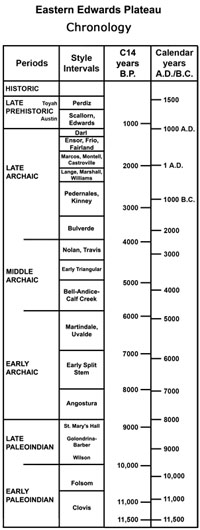Eastern Plateau Details
The eastern Edwards Plateau and the intertwined eastern Balcones Canyonlands have been the focus of intense archeological investigation since James E. Pearce began excavating sites in the Austin area around 1919. This concentration of effort is due to two related factors, ecology/hydrology and modern development.
Compared to the western Edwards Plateau and the Lower Pecos Canyonlands, the eastern Plateau is wetter and far more ecologically favorable for human settlement—a statement that is as true today as in was in prehistory. Prehistoric peoples seem to have been drawn to this area since Clovis times because of the natural concentration of resources: permanent springs and spring-fed rivers and streams, major forested valleys representing westward-stretching fingers of the Eastern Woodlands, attendant concentrations of desirable plants and animals, high quality flint (chert) for tool-making, and a ready supply of limestone cobbles for plant baking. There is plenty of flint and limestone elsewhere in the overall region, but the concentration of other natural resources is a reflection of climate and hydrology. Compared to farther west, the eastern Edwards Plateau is wetter, has a somewhat longer growing season, and has much more surface water because of higher rainfall amounts and the discharge patterns of the underground aquifers.
It is certainly not coincidental that the eastern Edwards Plateau has seen the highest concentration of population and development during the 19th and 20th centuries. Many of the same things that drew prehistoric peoples—permanent water, diverse resources, and valleys with deep soils—drew early Hispanic and Anglo settlers and more and more people today. As a direct consequence of the greater modern-era population and development, the eastern Plateau has seen far more archeological research than any other subarea of the region, especially the sparsely populated western Plateau. The fact that the University of Texas at Austin and the University of Texas at San Antonio are located in this region accounts for part of the research focus. But much of the research has taken place since the 1960s in response to federal and state laws. These laws pertain to federal and state funded development, federal and state lands, and federal and state development requirements.
The research concentration on the eastern Edwards Plateau has allowed archeologists to learn much about the prehistory of the area and also of the relatively recent climatic changes that have occurred since humans arrived on the scene some 13,500 years ago. These findings have been summarized by several different researchers over two decades in articles published in the Bulletin of the Texas Archeological Society, one of the leading regional archeological research journals relevant to the prehistory of Texas. Below are links to the two most recent summaries of the "central Texas" archeological region. Although this region includes all of the Edwards Plateau as well as strips of adjacent natural regions, especially the Blackland Prairie to the east, the vast majority of the data upon which interpretations are based comes from sites in the eastern Plateau and the Balcones Canyonlands.
Collins, Michael B.
1995 Forty Years of Archeology in Central Texas. Bulletin of the
Texas Archeological Society 66:361-400.
2004 Archeology in Central Texas, in The Prehistory of Texas, edited by Timothy K. Perttula, Texas A&M University Press. [Slightly revised version of 1995 article.]
Download Collins 2004 PDF file.
Johnson, LeRoy Jr. and Glenn T. Goode
1994 A New Try at Dating and Characterizing
Holocene Climates, as Well as Archeological Periods, on the Eastern Edwards
Plateau. Bulletin
of the Texas Archeological Society 65:1-51.
Download Johnson and Goode 1994 PDF file.
